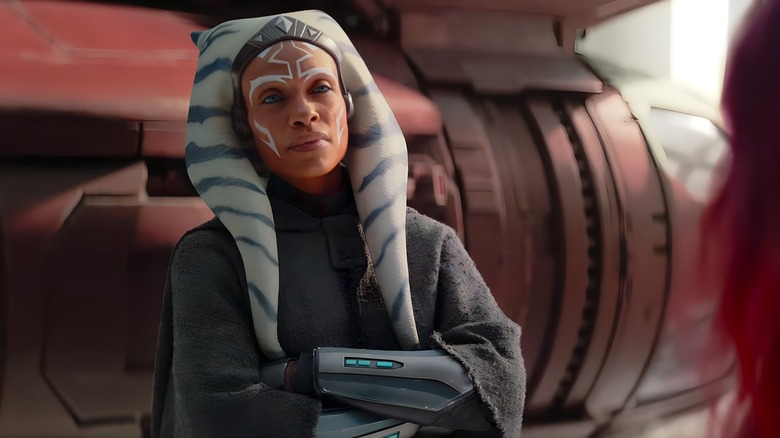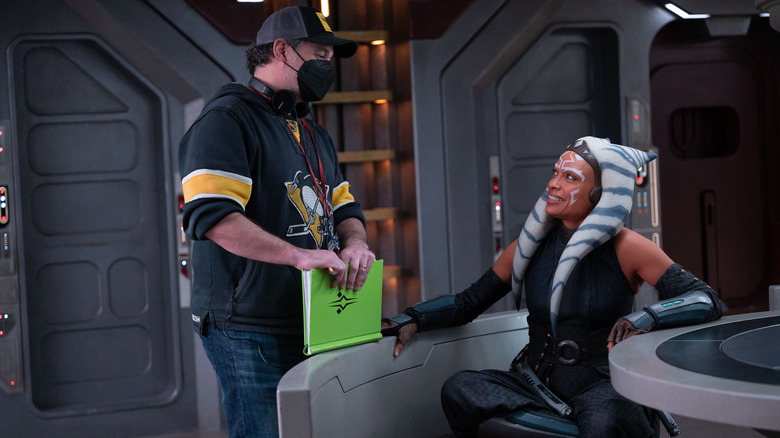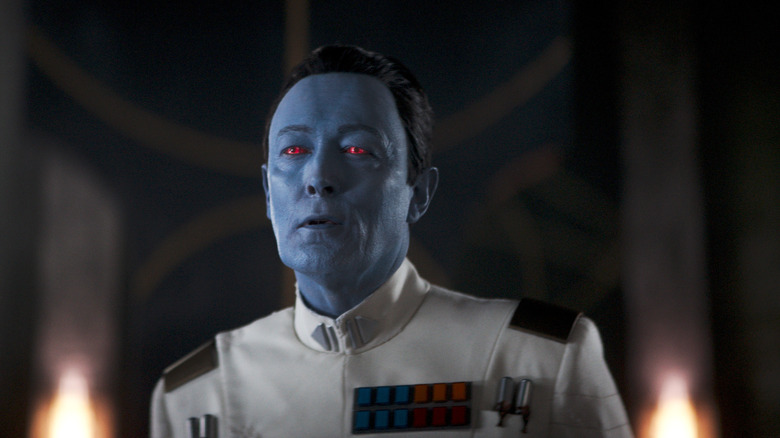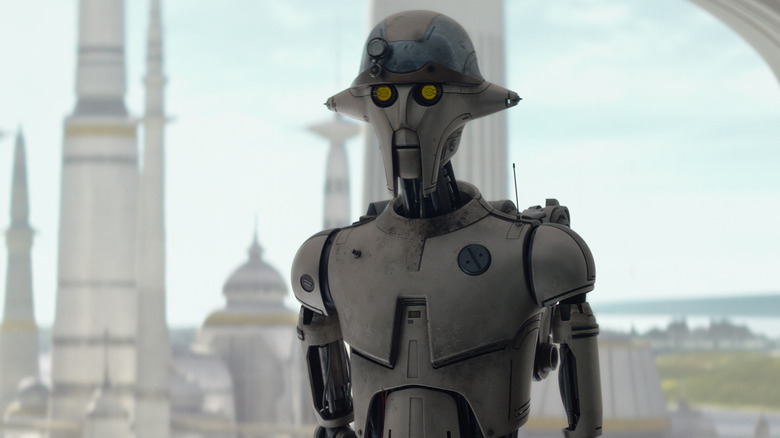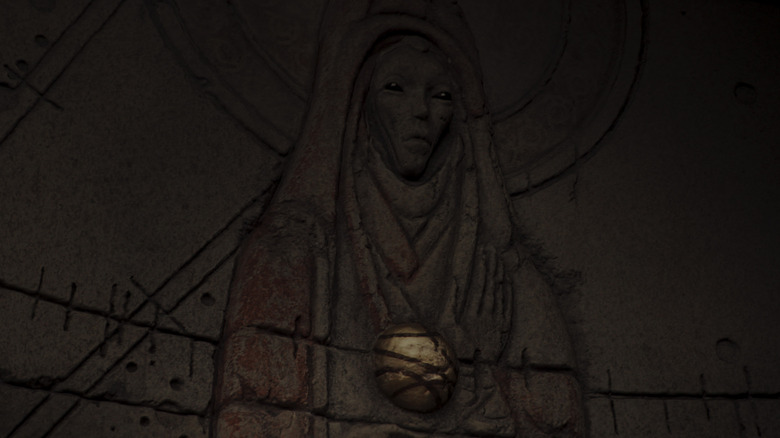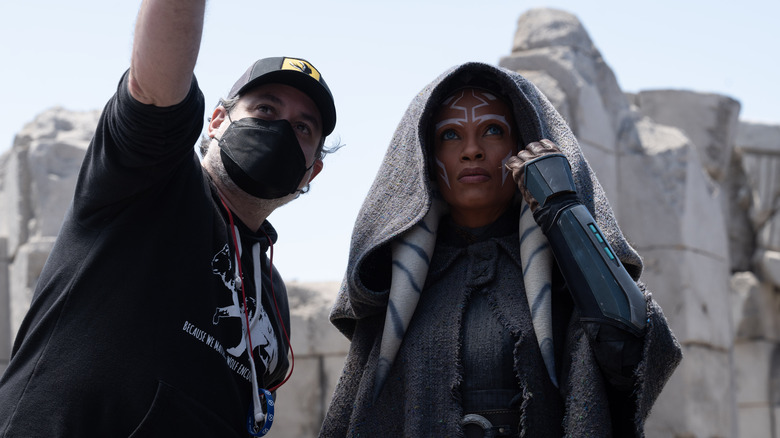Ahsoka Explores A 'Master And Apprentice' – And Sets Up A Captivating Star Wars Story
This article contains spoilers for "Star Wars: Ahsoka" episode 1 — "Master and Apprentice."
"Ahsoka" is the current culmination of a generation of television storytelling in the "Star Wars" universe. Led by Dave Filoni, who helped originate the character of Ahsoka Tano for "Star Wars: The Clone Wars" working under the direct tutelage of George Lucas, the show gives us a view of the New Republic and Anakin Skywalker's former Padawan Ahsoka (Rosario Dawson) on her quest to protect it from the likes of Grand Admiral Thrawn (Lars Mikkelson). Years have passed and it seems apparent that Ahsoka and Sabine Wren (Natasha Liu Bordizzo) have gone questing for Thrawn and their lost friend Ezra (Eman Esfandi) already and come up with nothing, straining their relationship. But now, Ahsoka has a map to another galaxy, a clue to where Thrawn might have been. The only person Ahsoka knows who might be able to crack the clue of that map is her former apprentice, Sabine.
They're not the only ones after Thrawn, though. A pair of dark side users who were once Jedi, Baylon Skoll (Ray Stevenson) and Shin Hati (Ivanna Sakhno), have been hired by the villainous Morgan Elsbeth (Diana Lee Inosanto, reprising her role from the second season of "The Mandalorian") to hunt down the map and bring Thrawn back to the galaxy and tear the New Republic apart.
Star Wars style storytelling
Dave Filoni writes and directs this first episode of "Ahsoka" on his own and brings to the forefront every bit of "Star Wars" storytelling he's learned over the years from George Lucas. Instead of giving us a straight continuation of the story from "Star Wars Rebels" as many expected, Filoni skips past that story and drops us in the middle of a situation that we're expected to make guesses about, putting viewers of all levels of "Star Wars" fandom on a level playing field. None of us know exactly what happened or why and it creates a mystery and an energy to the story that would have been absent otherwise.
He begins, as many "Star Wars" films do, with an opening crawl, though this is the first "Star Wars" television project to begin this way. This tells us that the story we thought we knew isn't exactly what we were expecting.
Filoni then draws from the openings of "Return of the Jedi" and "Attack of the Clones" to create something unexpected and exciting. Like Darth Vader's ship arriving at the Second Death Star, Baylon Skoll's shuttle arrives at a New Republic ship's docking bay, claiming to be Jedi from a forgotten time. But, like the assassin's explosion in "Attack of the Clones," the Jedi are revealed to be users of the dark side and they proceed to slaughter everyone aboard and free Thrawn's loyal servant, Morgan Elsbeth. It has visual moments that match "A New Hope" with the hallways and uniforms of the Rebels, but it also has an element of a dark version of Luke Skywalker rescuing Princess Leia from the Death Star. It's an exciting, thrilling opening that borrows from all the best parts of "Star Wars" storytelling, dropping us into the middle of a situation we can only make assumptions about with characters we don't yet know.
Filoni also draws subconscious parallels to elements of "Star Wars" we might not even realize. There's a reason that Hera Syndulla (Mary Elizabeth Winstead) and Ahsoka discuss the return of Thrawn in the same briefing room where Mon Mothma gave the Rebel Alliance its most dire briefing before the assault on the second Death Star in "Return of the Jedi." It's a subtle choice designed to make us believe that Thrawn's return is as much of a threat to the galaxy as Death Star II was.
The influence of other "Star Wars" movies are also present in the episode. Shin Hati, Baylan Skoll's dark apprentice, is sent on a mission to Lothal much like Darth Maul is sent to Tatooine in "The Phantom Menace." In both cases, they use probe droids to hunt their quarry and strike when their prey is unsuspecting. Unlike Maul, though, Shin Hati completes her mission, stealing the map that may lead to Thrawn and Ezra and viciously wounding Sabine Wren.
Filoni cribs from his work on "Star Wars: The Clone Wars" and "Star Wars Rebels" as well, creating a coherent visual style that passes seamlessly between animation and live-action, proving he's the right person for this particular job. He learned from the master and he's putting everything he learned on display. In fact, there was something about watching it that felt like reading those early drafts of "The Star Wars" from 1974, like Filoni had captured some of that vitality that Lucas had in his earliest days in a galaxy far, far away.
Heir to the Empire
Many fans are looking forward to this particular project because of its inherent ties and comparisons it will draw to Timothy Zahn's "Heir to the Empire" trilogy of books. In 1991, when it seemed like "Star Wars" was all but dead, Bantam Books launched a new initiative to put out a sequel to the classic trilogy. Upon its release, "Heir to the Empire" became a runaway hit, hitting the New York Times Bestseller Lists and reinvigorating interest in "Star Wars" in a way that some could argue paved the way for the Special Edition releases of the films, the prequel trilogy, and the current renaissance of "Star Wars" storytelling. In those books, Thrawn comes back from the unknown regions long after the Empire has been defeated and the New Republic has been established. The heroes of the Rebellion — Luke, Han, Leia, and so forth — are forced to contend with a foe unlike any they had ever fought. Thrawn was ruthless and calculating and a brilliant tactician. Where Tarkin, Vader, and Palpatine ruled with cruelty and fear, Thrawn commanded with dignity, superior tactics, competence, and loyalty.
Of course, the nature of the "Star Wars" canon means that we can't get a 1:1 translation of this story, but there are hints that Dave Filoni is including as many flourishes as he can and that starts with the use of Baylon Skoll and Shin Hati. In "Heir to the Empire," one of Thrawn's allies and later rivals was a clone of a Jedi named Joruus C'Baoth who tries to tempt Luke Skywalker and Leia Organa Solo to the dark side of the Force. Baylon Skoll seems as though he could very much fill a similar role with Ahsoka Tano, especially as it seems both of them left the Jedi Order on not-so-great terms near the end of the Clone Wars.
Skoll and Hati represent much more than just this lure to the Dark Side, though. Clues about their quest for power may be hidden in the significance of their names. In Norse Mythology, Skoll and Hati are the wolf-giant children of Fenrir, one ever chasing the sun to devour it, the other ever chasing the moon in order to bring about Ragnarok. In "Star Wars," the return of Thrawn and the destruction of the New Republic feels like it would have an impact equivalent to Ragnarok.
Details to watch out for
There are numerous references to watch out for in this episode of "Ahsoka," and many of them tie back to things we know and do wonders to enhance the storytelling. Others are just cool.
The first one you might notice is that Captain Hayle — the man who calls Baylan Skoll's bluff at the beginning of the episode — is a familiar face in nerd circles. That's Mark Rolston, who played the Colonial Marine Drake in "Aliens." He's not the first actor from "Aliens" Dave Filoni has brought into "Star Wars" either. Michael Biehn (Hicks in "Aliens") made his "Star Wars" debut in the same episode of "The Mandalorian" as Morgan Elsbeth and Ahsoka Tano.
Another revelation from this episode concerns Morgan Elsbeth, who turns out to be a descendent of the Witches of Dathomir. For longtime fans, this opens a world of possibilities for potential story hooks. The Witches were the same order that produced Asajj Ventress. Their planet was devastated by General Grievous during the Clone Wars and there were few survivors left. Players of the "Jedi: Fallen Order" and "Jedi: Survivor" games will recognize the remnants of that order in the character of Merrin.
Filoni also brings in more elements of "Star Wars Rebels", raising the specter that this might just be a direct sequel to that show. Not only do we get Mary Elizabeth Winstead as Hera Syndulla, but we even get Clancy Brown reprising his animated "Rebels" role as Governor Ryder Azadi and a live-action iteration of Jai Kell — a character Ezra helped escape from the Imperial Academy. As we meet Sabine, she's even living in the same abandoned communications tower that Ezra made his home in when he was living on his own. The apartment is even full of Ezra's effects, including his collection of Stormtrooper helmets.
Another addition? Huyang, who was introduced during an important arc of "Star Wars: The Clone Wars" — one that originally won David Tennant (who returns to voice the character here) an Emmy.
Lastly, fans will be happy to see the live-action debut of the E-Wing. These ships first appeared in "Star Wars: Dark Empire," a series of comic books released in the early '90s. They've been important workhorses in the expanded universe, but have only recently gained traction in the new iterations of the "Star Wars" canon.
The Well of Souls
Like his mentor, George Lucas, Dave Filoni makes no bones about bringing references and moves in from other films. Lucas made a habit of taking the best moments from his favorite movies that were influential to him and bringing them into "Star Wars." There's no doubt that Filoni is doing the same thing here. For the most part, it seems like Filoni brings in his love of "Star Wars", but the very first scene in "Ahsoka" was clearly modeled after "Indiana Jones and the Raiders of the Lost Ark."
As Ahsoka descend into an ancient temple, it bears all the visual hallmarks of Indiana Jones descending into the Well of the Souls, changing the light and in ways that affect what she's looking for. As she manipulates the stone pillars, it is just as reminiscent of Indy taking the golden idol at the beginning of "Raiders of the Lost Ark."
Positioning this scene for Ahsoka at the beginning of the narrative also gives it that feeling of capping off the last adventure that we don't actually see, another hallmark of the "Indiana Jones" films.
Quiet certainty
Dave Filoni directs this first episode with a quiet certainty. On one hand, it feels very much like "Star Wars", but on the other hand, there's a Kurosawa-like stillness to much of it. Part of that comes from the stoicism of the lead character, other parts come from the fact that Filoni trusts us enough to understand the context of the gravitas without a lot of flashy prodding. The overall effect of the show creates something that ties into the deep history of the Skywalker Saga, blending it with Jon Favreau's approach on "The Mandalorian" and Filoni's animation sensibilities, while at the same time remaining exciting on its own.
The components are all there. With an eye for detail borne through his training in animation, Filoni packs everything with the sort of story flourishes, even deep in the background, that provide rich opportunities for subtle storytelling.
Kevin Kiner's music hearkens back to the work of John Williams and his own extensive work through "The Clone Wars" and "Rebels." The effects are movie quality and the talent that bring the characters to life is astounding. There is still a lingering question at this point, though, of what Mary Elizabeth Winstead and Natasha Liu Bordizzo are bringing to the table that the originators of their characters, voice actors Vanessa Marshall and Tiya Sircar, couldn't bring, but the characters we know so well do feel perfectly represented.
The standouts, performance wise, though, might be Ray Stevenson and Ivanna Sakhno. Stevenson has an understated quality to him that I want to learn more about and Sakhno is absolutely magnetic every time she's on the screen, compelling and complex and I'm not even sure why yet. I hope we learn more soon.
Though I think Filoni could have begun the show by pushing a little harder, I understand that he was making this for two different audiences: the new fans coming to these characters for the first time, and the longtime fans. He's been able to split the difference though, and I imagine most audiences will leave happy.
Let's just hope the studios end the strike soon and they let the creatives go back to work to make more for us.
New episodes of "Ahsoka" premiere on Tuesday nights on Disney+ at 6:00 pm Pacific, 9:00 pm Eastern.
